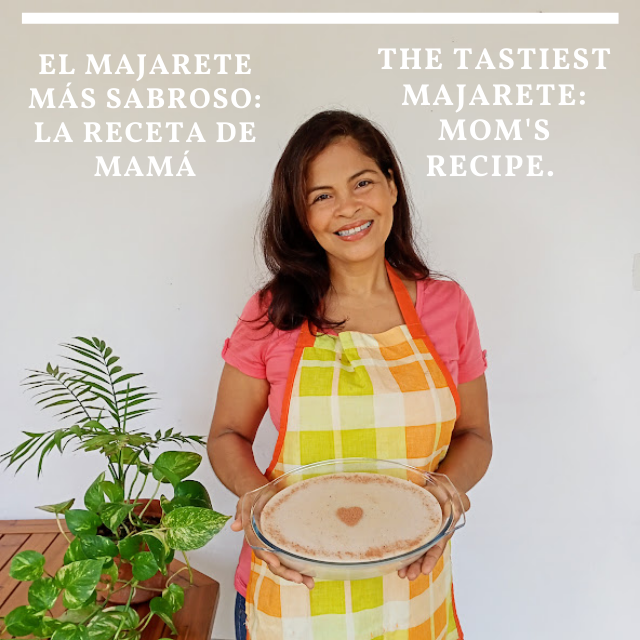
Estoy muy contenta de participar en el primer concurso Foodies de Dulces o Postres Tradicionales. En seguida que supe de esta edición, me animé y pensé en la receta súper famosa del MAJARETE de mi madre que siempre he querido hacer. Es una fórmula magistral de sabor tradicional donde los ingredientes principales son el coco y el maíz. En mi familia y entorno, dicen que su majarete es insuperable, yo también lo creo. Les soy sincera, a mi no me gustaba este dulce, pero luego fue poco a poco gustándome su sabor.
Éste dulce venezolano tiene sabor colonial; data de la época en que el país dependía de España y seguramente fue producto de la unión de culturas y sazones en aquel tiempo. Algunos pregonan que proviene de Miranda, estado de Venezuela.
Se elaboraba sobre todo en tiempos de cuaresma, que es el período en que se prepara la pascua para conmemorar la muerte y resurrección de Jesucristo.
La receta original se preparaba con maiz sancochado y papelón, según pude leer en Temporadista.com
Mi mamá lo aprendió a hacer de su madre y quise reproducir su receta que preserva el procedimiento original, con excepción de que usa la harina precocida de maíz y no la masa artesanal de maíz. Voy a tratar de explicarla de la mejor manera posible para que quede para las futuras generaciones y todos podamos beneficiarnos en la blockchain.
En seguida, les muestro el paso a paso.
I am very happy to participate in the first Foodies contest of Traditional Sweets or Desserts. As soon as I heard about this edition, I got excited and thought of my mother's super famous MAJARETE recipe that I have always wanted to make. It is a masterful formula of traditional flavor where the main ingredients are coconut and corn. In my family and environment, they say that her majarete is unbeatable, I think so too. I'll be honest, I didn't like this sweet, but then I gradually began to approve of its taste.
This Venezuelan sweet has a colonial flavor; it dates back to the time when the country depended on Spain and was surely a product of the union of cultures and seasonings at that time. Some say that it comes from Miranda, state of Venezuela.
It was made especially during Lent, the period in which Easter is prepared to commemorate the death and resurrection of Jesus Christ.
The original recipe was prepared with parboiled corn and papelón, according to Temporadista.com
My mom learned to make it from her mother and I wanted to reproduce her recipe which preserves the original procedure, except that it uses precooked corn flour and not the artisanal corn dough.
I will try to explain it in the best possible way so that it remains for future generations and we can all benefit from the blockchain.
I will show you the step by step below.
¿Cómo lo hice? 🍝 How did I do it?
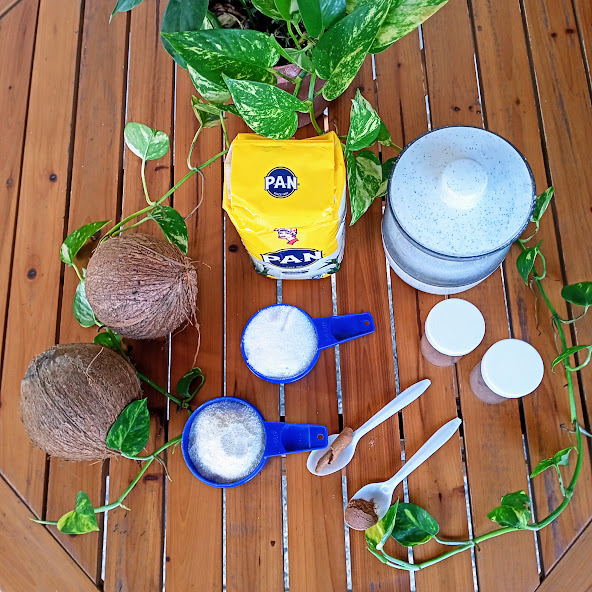
2 cocos secos medianos
2 tazas de harina de maíz
1 y 1/2 taza de azúcar
2 vasos de agua
Canela en ramas
Canela en polvo
1 cucharadita de sal
2 medium dry coconuts
2 cups corn flour
1 and 1/2 cups of sugar
2 cup of water
Cinnamon sticks
Powdered cinnamon
1 teaspoon of salt
1
En primer lugar lo que hice fue romper los cocos, y extraer la pulpa interna y picarla en trocitos para luego licuarla en la licuadora con 1 vaso de agua.
First of all, what I did was to break the coconuts, and extract the internal pulp and chop it into small pieces and then grate it in the blender with 1 glass of water.
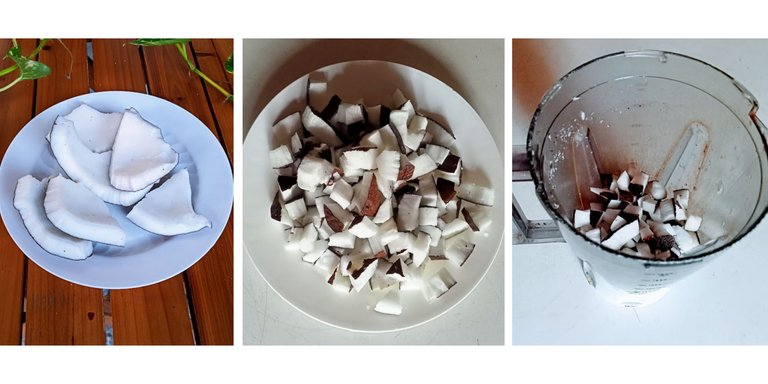
Es importante usar agua para que la licuadora no sufra. Hay personas que rallan el coco pero mi mamá lo hace más práctico.
It is important to use water so that the blender does not suffer. Some people grate the coconut but my mom does it more conveniently.
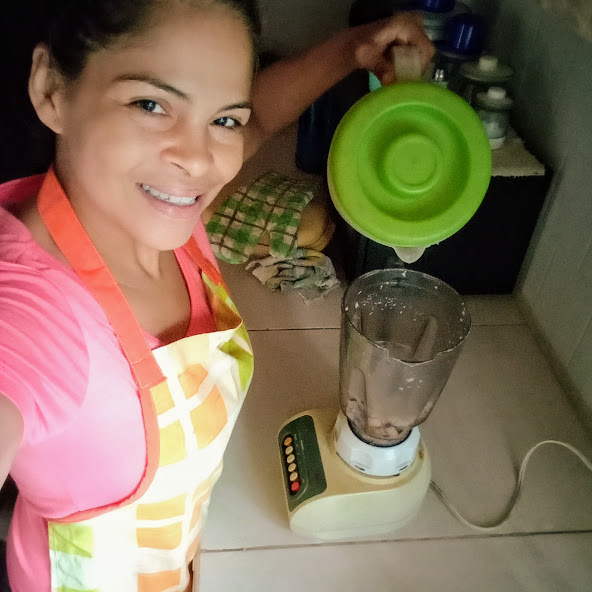
2
Luego, se cuela ese licuado, obteniendo una especie de leche. No basta el colado, también es necesario exprimir con la mano para sacar todo el extracto de sabor del coco. Después se separa ese liquido en dos porciones. Se reservan.
Then, this liquefied is strained, obtaining a kind of milk. The straining is not enough, it is also necessary to squeeze it by hand to extract all the coconut flavor extract. Then the liquid is separated into two portions. Reserved
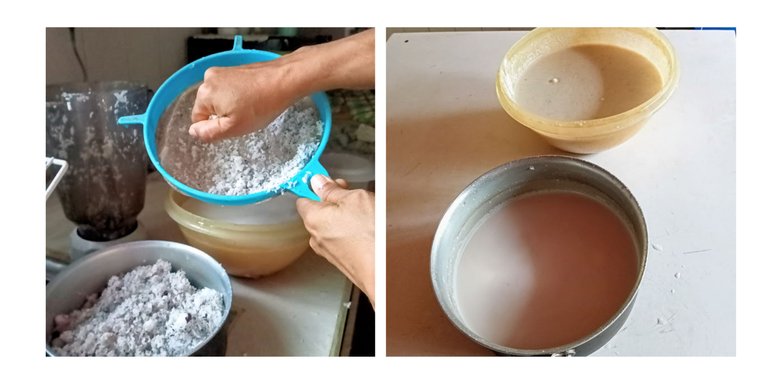
3
A una parte de la leche extraída del coco, se le agregan las dos tazas de harina de maíz y se mezclan con una paleta. Resulta mejor si se añade poco a poco porque pueden hacerse grumos y hay que meter la mano para deshacerlos. A mi me pasó, pero tranquilos, no pasa nada.
Si la mezcla se hace espesa, se le puede agregar más líquido que tenemos en reserva. Esta mezcla pronto se usará.
To part of the milk extracted from the coconut, add the two cups of corn flour and mix with a paddle. It is better if it is added little by little because lumps can form and you have to put your hand in to break them up. This happened to me, but don't worry, it's okay.
If the mixture becomes thick, you can add more liquid that you have in reserve. This mixture will soon be used.
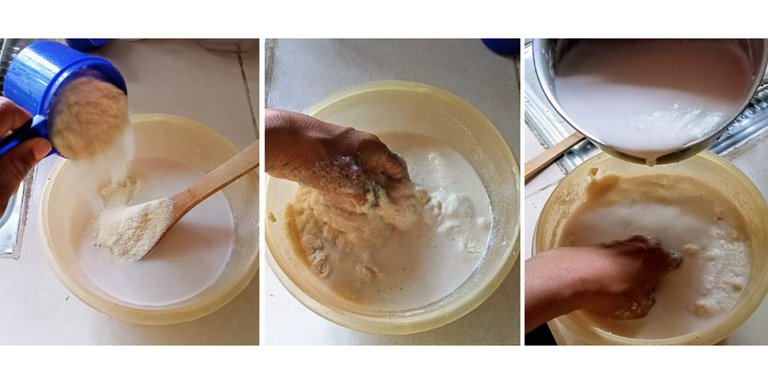
4
En una olla, cacerola o caldero, se coloca a hervir otro vaso de agua con unas ramitas de canela.
In a pot, pan or cauldron, boil a cup of water with a few cinnamon sticks.
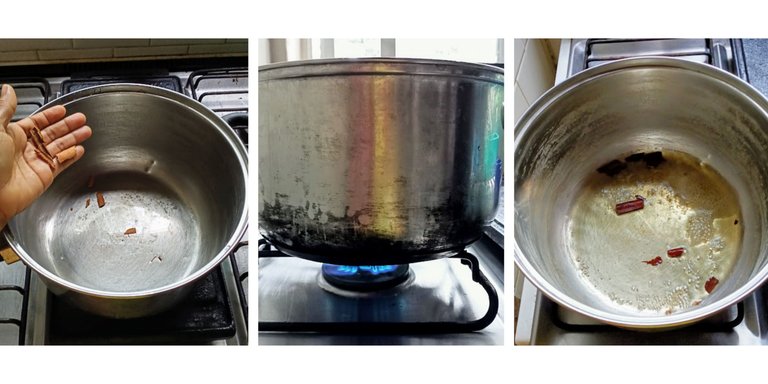
5
Después de todo esto se vierte la mezcla de la harina en la olla con la canela y se bate con cuidado. Este es el momento de agregar la sal y el azúcar. Se va comprobando el sabor.
After all this, pour the flour mixture into the pot with the cinnamon and whisk carefully. This is the moment to add the salt and sugar. Check the taste.
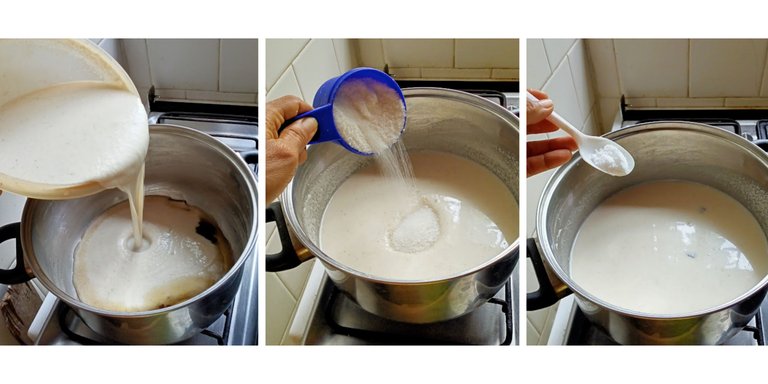
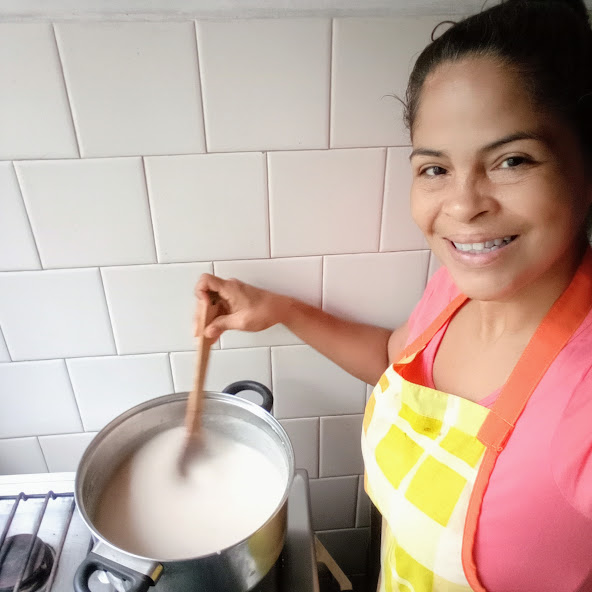
6
Finalmente se agrega la leche restante que teníamos reservada y se bate hasta dejar hervir la preparación. Se baja del fuego y se vierte en los moldes que desees. A mi me rindió para obtener dos moldes pequeños y uno mediano.
Se adorna con canela molida y se sirve frio o caliente.
Finally, add the remaining reserved milk and beat until the mixture boils. Remove from the heat and pour it into the molds you want. I had enough for two small and one medium molds. Garnish with ground cinnamon and serve hot or cold.

Les quiero confesar algo. Yo aprendí a disfrutar este dulce comiéndome lo que quedaba pegado de la olla. Suena ordinario pero es una delicia. Me lo copié de mi hermana @marigmt. Ella siempre reclamamba la olla cuando mi mamá hacía majarete. Ahora está en Argentina con su esposo y entonces soy yo quien me quedo con el recipiente. Ella sonreirá al leer esto.
I want to confess something. I learned to enjoy this sweet by eating what was left over from the pot. It sounds ordinary but it is a delight. I copied it from my sister @marigmt. She always reclaimed the pot when my mom made majarete. Now she's in Argentina with her husband and so I'm the one who gets the pot. She will smile as she reads this.
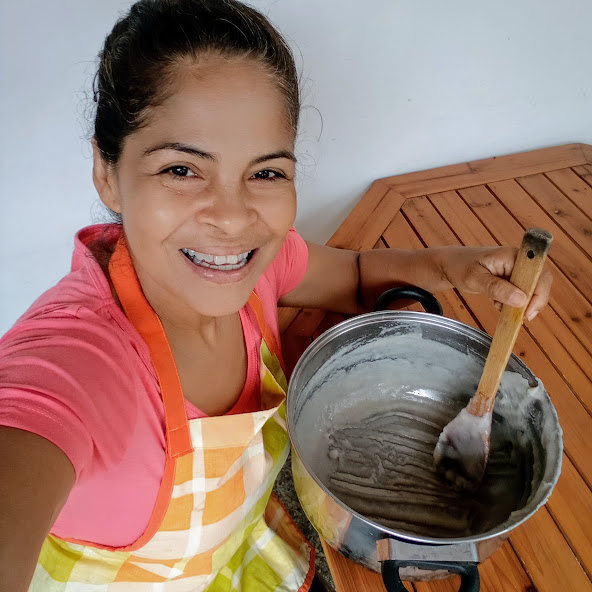
Deseo que practiquen esta sabrosa receta y la compartan con sus familiares y amigos y disfruten un dulce momento. Invito a participar en el concurso a mi amiga @g2ml. Espero le de tiempo como a mi de realizar su dulce criollo.
I wish you to practice this tasty recipe and share it with your family and friends and enjoy a sweet moment. I invite my friend @g2ml to participate in the contest. I hope she has time to make her sweet criollo like me.

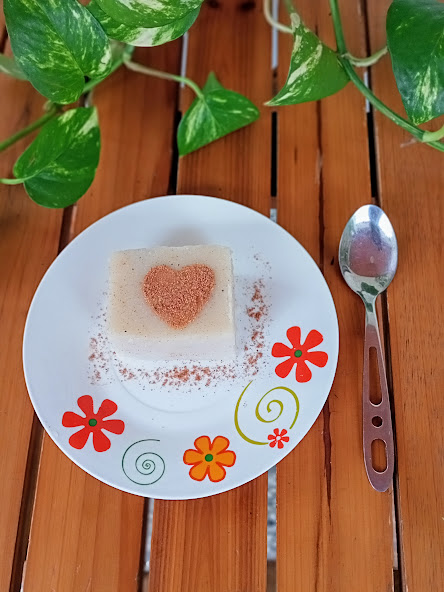
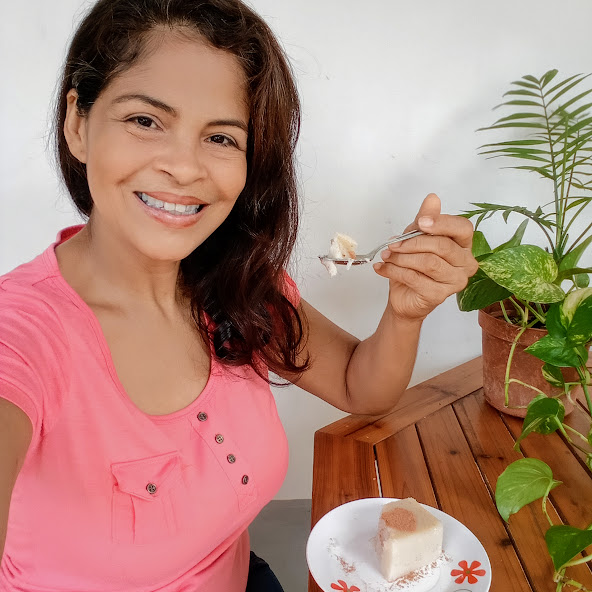
Until another time, my dear hivers.

Nota/Note
de mi teléfono REALME C3 y editadas en Canvas.
La traducción fue realizada en DeepL
...
All pictures were taken with the camera
of my REALME C3 phone and edited in Canvas.
The translation was done at DeepL
The rewards earned on this comment will go directly to the person sharing the post on Twitter as long as they are registered with @poshtoken. Sign up at https://hiveposh.com.
FoodiesUnite.net Yum! You have been curated @taco.cat on behalf of on #Hive. Thanks for using the #foodie tag. We are a tribe for the Foodie community with a unique approach to content and community and we are here on #Hive.
Join the foodie fun! We've given you a FOODIE boost. Come check it out at @foodiesunite for the latest community updates. Spread your gastronomic delights on and claim your tokens.
Join and Post through the Community and you can earn a FOODIE reward.
Thank you!
Me encanta el majarete pero no sabía cómo se preparaba, voy a guardar la receta, se ve que te quedó exquisito.🤤😍 gracias por compartirlo mi bella amiga.🤗
Es una súper receta, amiga. Cuando tengas el chance, lo haces.
Se vé muy sabrosa y si así la hacía Juanita, está certificada, felicitaciones amiga.
Si, cariño, quedó súper rico. Gracias por venir a degustar.
Felicidades mana! Es el mejor que he probado y me da mucho gusto que te hayas animado a heredar esa increible y rica receta. Ah! Te presto mi cacerola por un tiempo😊!